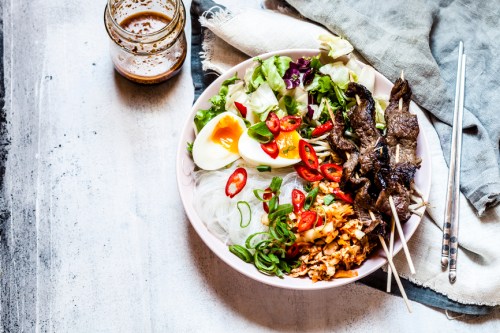If you ask me, condiments are the taste-masking MVPs of most meals. At any given time, I have at least a dozen varieties stocked in my fridge door and pantry, ranging from sauces and spreads to pastes hailing from all around the world. They’re often nestled alongside my go-to fermented foods—think kimchi, sauerkraut, and kombucha—and some Korean condiments new to my rotation just so happen to be fermented, too.
Experts in This Article
registered dietitian and author of The MIND Diet
Interested in racking up a variety of health benefits and making more delicious meals daily? We asked Maggie Moon, MS, RD, a culinary-school trained dietitian and the founder of Kimchi Curious, to share her expertise on fermented Korean condiments and tips for integrating them into your meals.
An intro to fermentation and how it’s used in Korean cuisine
Of course, fermentation isn’t exclusive to Korean cuisine, though Moon mentions that this process of food preservation is deeply rooted in her heritage. “Fermentation has been part of Korean food culture for thousands of years and allowed foods to be enjoyed in months of scarcity, such as during winter,” she says. Moreover, South Korea’s national dish is kimchi, which is arguably the most popular Korean banchan (side dish) that’s also integral to countless Korean meals. In fact, kimchi is so ubiquitous and revered that many Korean households have an extra refrigerator solely to meet the proper storage conditions for this fermented food.
“Some essential Korean pantry items are also fermented—including gochujang, doenjang, and gukganjang,” Moon continues. (More on these below.) “They are fermented in oxygen-free (anaerobic), acidic, and salty environments, which are the exact conditions that are unfavorable to ‘bad’ bacteria that cause food to spoil.” As is the case with other fermented foods, consuming these Korean condiments helps to create a more acidic environment in the gut, allowing friendly bacteria to thrive while halting pathogenic bacteria in its tracks.
And while salt aids the process of fermentation, Moon notes that the sodium content shouldn’t cause too much concern. “Traditional Korean fermented foods are salty, yet those who eat a traditional Korean diet have lower blood pressure and better glucose control than people eating a typical Western diet,” she says.
An RD’s 3 favorite fermented Korean condiments
If you’re anything like me and your mouth is already watering at the mere thought of delicious Korean food, you’ll want to stock up on these fermented conditions, stat.
1. Gochujang
“Gochujang is a fermented paste made primarily of gochugaru (Korean chili powder), sweet rice powder, and soybeans,” Moon says. Not only is it a staple in Korean cuisine, but it’s also linked to some impressive benefits for gut health and beyond. According to a 2021 study, gochujang “induced significant modulation in gut microbiota by significantly increasing the number of Akkermansia muciniphila,” a type of healthy bacteria. “When more A. muciniphila is present, research suggests there’s less inflammation, type 2 diabetes, and metabolic disorders,” Moon continues.
Moon also recommends trying cho gochujang, a sauce that includes cho (vinegar), fresh minced garlic, and sometimes sugar or another sweetener. “You can also add a small amount of toasted sesame seed oil, sesame seeds, or sliced green onion whites for taste,” Moon shares—all of which are common ingredients in Korean cuisine, as well.
As for her top tips for adding this condiment to your diet? “My mom serves Korean cucumber spears, radicchio, and grape tomatoes with cho gochujang for dipping,” says Moon. “This sauce is also used as a dressing for bibimbap (a Korean rice dish) and cooked vegetables, or dipping sauce for squid or raw seafood.” If you want to get creative, Moon also suggests subbing it for dishes that call for barbecue sauce.
2. Doenjang
“Doenjang is made from fermenting cooked and crushed soybeans; it is considered one of the ‘mother sauces’ of Korean cuisine,” Moon shares. Korean barbecue restaurants usually have doenjang jjigae (fermented soybean paste stew) on the menu, and often serve it as part of a combination meal.
“Doenjang is a source of amino acids, vitamins, minerals, and other compounds with antioxidant and anti-inflammatory effects,” Moon says. “It contains polyphenols called isoflavones, which, combined with probiotics, have been shown to support gut health and promote calcium uptake for healthy bones.”
While she personally recommends whipping up your own hearty doenjang jjigae, Moon says that doenjang is also a key ingredient in ssamjang, “a flavorful sauce that adds a punch of flavor to ssam (wraps) that usually refer to wraps made with lettuce or even seaweed.” Gochujang is another key ingredient in ssamjang—which also may include garlic, minced green onion, onion, sesame, and sweetener—so the latter is a great option if you want to get more fermented bang (and health benefits) for your buck.
If you want to make your own ssam, Moon says that there are countless ways to do so. “What goes inside a ssam varies, but it can be some combination of rice, vegetables, kimchi, barbeque meat, seafood, and more,” she says. “With so much variety per lettuce wrap, ssam has the potential to offer up balanced nutrition in every bite.” Otherwise, Moon suggests adding ssamjang to soups, stews, stir frys, burgers, sandwiches, or eggs.
Just one important FYI before you load up on the fermented goodness: “It’s very flavorful and a little goes a long way, so I’d recommend starting small so it doesn’t overpower a dish,” Moon notes.
3. Ganjang
Last up, Moon recommends checking out different types of ganjang (soy sauce). “Traditional Korean ganjang is called gukganjang and is a byproduct of fermenting soybeans from doenjang. It contains just soybeans, salt, and water, whereas some soy sauces are combined with wheat to make it sweeter,” she explains, also noting that gukganjang tends to be saltier than other soy sauces you may be more familiar with.
“Ganjang also has antioxidant potential, plus phytochemicals that are associated with heart health,” says Moon. She adds that its dark color comes from melanoidins, which “behave not only as antioxidants, but also as dietary fibre by promoting the growth of bifidobacteria,” as one medical review notes.
Also on offer is cho ganjang, which is “vinegar with ganjang, often with black pepper and sometimes with just a drop of toasted sesame seed oil and sesame seeds,” Moon says. “It is a super simple sauce that is commonly found served with snack foods like mandu (dumplings), jeon (savory pancakes), or twigim (battered and fried vegetables), and it can also be used to season broth.”
Finally, if your palate prefers a plenty of seasoning, Moon suggests opting for yangnyeom ganjang, a dipping sauce which she calls “the loaded-up cousin to simple cho ganjang.” As she explains, this type of ganjang “has chopped green onions, minced garlic, toasted sesame oil, and sesame seeds, and it can be made with or without gochugaru.” Moon recommends enjoying its hearty texture atop whole broiled fish or pan-fried tofu. (Swoon.)
Sign Up for Our Daily Newsletter
Get all the latest in wellness, trends, food, fitness, beauty, and more delivered right to your inbox.
Got it, you've been added to our email list.











